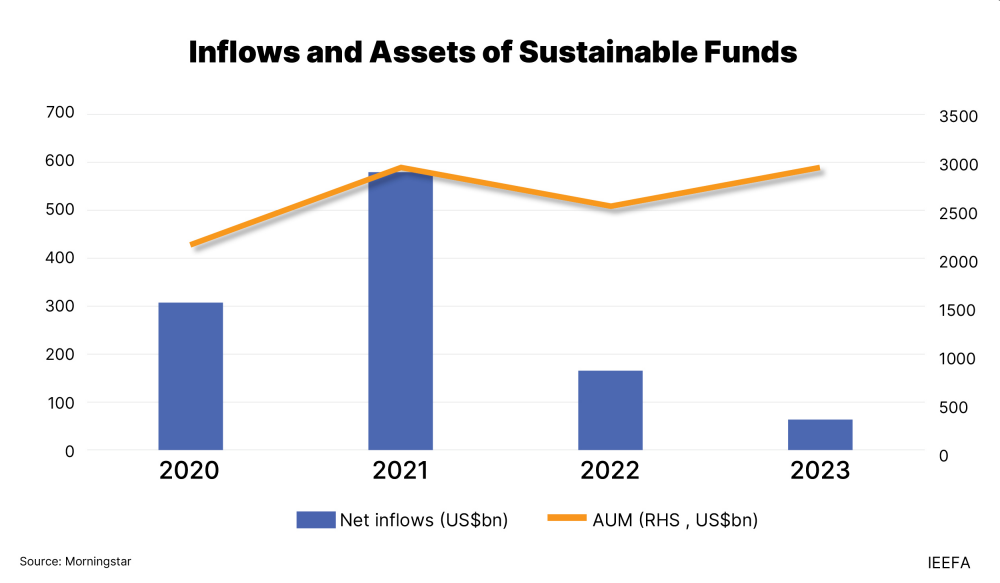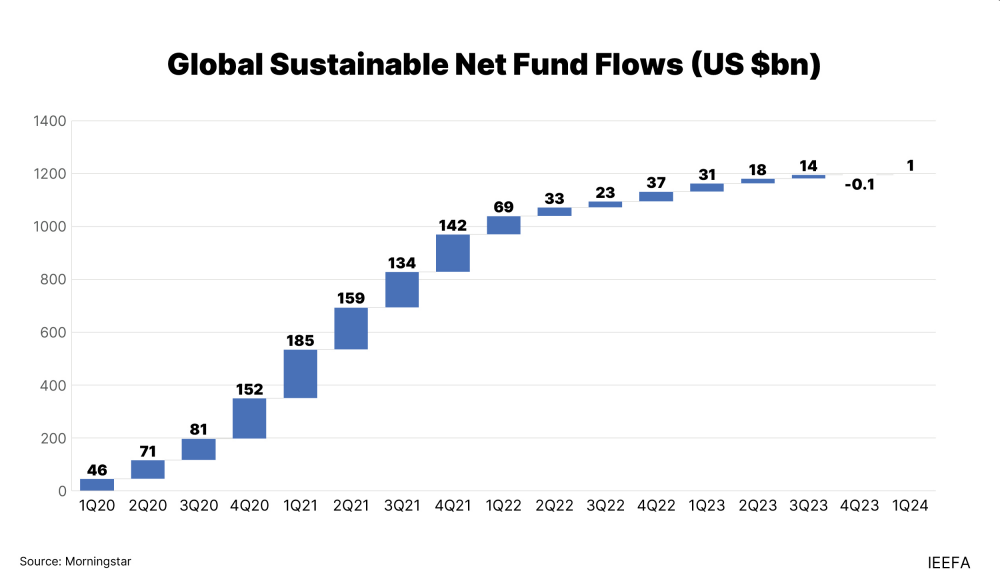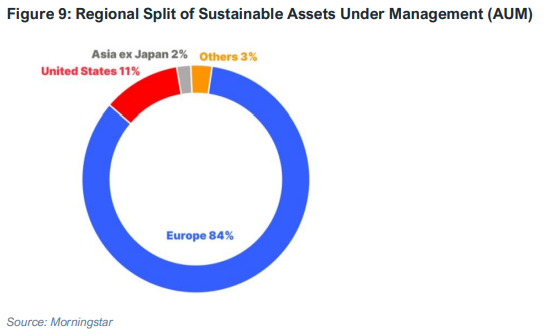
 Inflows into ESG (environmental, social, and governance) funds remain strong, especially in Europe. That’s despite high interest rates and the boost to oil and gas from Russia’s invasion of Ukraine. According to a new report by Ramnath Iyer at IEEFA, in 2023 the performance of ESG funds and exchange-traded funds (ETFs) matched or surpassed that of traditional funds and ETFs. Morningstar figures reveal that sustainable funds had a median return of 12.6% versus 8.6% for traditional funds. And in the first quarter of 2024, Europe saw an inflow of almost $11bn into the ESG asset class. However, in the U.S. the politicisation of green energy has resulted in outflows. Iyer summarises his review of actual performance, the constraints on ESG funds, fund flows, and regional differences.
Inflows into ESG (environmental, social, and governance) funds remain strong, especially in Europe. That’s despite high interest rates and the boost to oil and gas from Russia’s invasion of Ukraine. According to a new report by Ramnath Iyer at IEEFA, in 2023 the performance of ESG funds and exchange-traded funds (ETFs) matched or surpassed that of traditional funds and ETFs. Morningstar figures reveal that sustainable funds had a median return of 12.6% versus 8.6% for traditional funds. And in the first quarter of 2024, Europe saw an inflow of almost $11bn into the ESG asset class. However, in the U.S. the politicisation of green energy has resulted in outflows. Iyer summarises his review of actual performance, the constraints on ESG funds, fund flows, and regional differences.
Key Findings
- Environmental, social, and governance (ESG) investing has grown rapidly in investor and public consciousness between 2017 and 2022. Despite recent debate, inflows into sustainable funds remain strong, especially in Europe. In 2023, the performance of ESG funds and exchange-traded funds (ETFs) matched or surpassed that of traditional funds and ETFs.
- In 2023, as per independent fund investment research house Morningstar, sustainable funds had a median return of 12.6% versus 8.6% for traditional funds. This outperformance extended across equity and fixed-income funds asset classes.
- Europe, the most advanced regionally in embracing sustainable funds, saw an inflow of almost US$11 billion into this asset class in the quarter ended March 2024. In contrast, ESG investing appears politicised in the United States and is seeing outflows.
- Regulators are increasing their focus on climate risk, and there is a drive for transparency and robust reporting on climate and ESG matters. There are clear signs of greater regulatory support in Europe and many Asian countries, which indicate climate, sustainability, and ESG policies are being further adopted by the mainstream. Asset owners also want increased ESG considerations in investments.
This analysis is for information and educational purposes only and is not intended to be read as investment advice.
IEEFA Report: “ESG Investing: Steady Growth Amidst Adversity”
Environmental, social, and governance (ESG) investing grew rapidly in both investor and public consciousness between 2017 and 2022, but has recently faced backlash from certain quarters. Despite the assets under management (AUM) of funds defined as “sustainable” by Morningstar, the mutual fund research company, reaching nearly US$3 trillion (tn) by the end of 2023, a series of interest rate hikes to contain inflation led to poor performance for ESG funds. Politicians in the U.S. and elsewhere, particularly those that support fossil fuel interests, have mounted sustained attacks on ESG, labelling it as idealistic and against national interests. In response, some companies and fund managers have either reduced their emphasis on ESG or disassociated from groups aiming to address issues like climate change and governance.
This report analyses the actual performance and returns of ESG-related funds and investments, the fund flows into and out of these funds, and the regional differences and their implications. It also explores regulatory trends and oversight of capital markets, as well as the perspectives and intentions of large investors and asset owners. The findings indicate that ESG continues to grow and remain relevant. The performance of ESG funds and exchange-traded funds (ETFs) has matched or surpassed traditional funds/ETFs over most time periods. Regulators continue to focus on climate change risks, and on improving standards and disclosures to assess and mitigate these risks.
Actual performance
In terms of performance, sustainable funds outperformed and generated better returns than traditional funds in 2023, with a median return of 12.6% versus 8.6% for traditional funds. This outperformance was seen across both equity and fixed-income asset classes. This is not an anomaly as sustainable funds have outperformed traditional funds’ returns every year from 2019, except in 2022. Similarly, in terms of ETFs, the median ESG ETF outperformed the median traditional ETF in three of the last four years.
Interest rates, Russia’s war on Ukraine
A significant difference between the investment exposures of sustainable and traditional funds is the former’s underweighting of the energy sector. In 2023, the clean energy sector underperformed in the broader market or the S&P500 due to sharp interest rate increases. Meanwhile, the war between Russia and Ukraine gave an exogenous boost to oil and gas prices, allowing energy stocks to recover from a decade of serial underperformance. The negativity surrounding clean energy and arguments favouring fossil fuel stocks appear to be a case of recency bias. Despite windfall gains for the oil and gas sector due to Russia’s war on Ukraine, these stocks have not outperformed clean energy over the past decade.
Fund flows
Organic fund flows for the sustainable funds sector remained positive in 2023, with net inflows of 2% of the starting fund base. This growth outpaced the overall funds industry which saw an organic growth rate of just 0.17%. Despite a significant slowdown, the ESG/sustainable fund industry still grew faster than the overall fund industry, accounting for 6.6% of overall funds at the end of 2023.

SOURCE: “ESG Investing: Steady Growth Amidst Adversity” by Ramnath Iyer, IEEFA

SOURCE: “ESG Investing: Steady Growth Amidst Adversity” by Ramnath Iyer, IEEFA
Europe, U.S., Asia
The first quarter of 2024 (1Q2024) saw a small outflow of US$900 million (mn). However, this was largely driven by a large outflow of US$8.8 billion (bn) from the U.S. out of these funds. By contrast, Europe, the most advanced regionally in terms of embracing sustainable funds, experienced an inflow of almost US$11bn into this asset class. This inflow, far from declining, was more than double the previous quarter’s subscriptions. Although news from the U.S. tends to be amplified, it is important to remember that Europe is the origin for 84% of funds under management in this category.

SOURCE: “ESG Investing: Steady Growth Amidst Adversity” by Ramnath Iyer, IEEFA
The difference extends beyond the quantum of investment flows. The commitment that many U.S. fund houses have towards ESG appears to be weaker compared to European ones, as evidenced by surveys of asset managers. Similar surveys of asset owners and investors show a growing drive to integrate sustainability and ESG in their investment processes.
Regulators are increasing their focus on climate risk, pushing for more transparency, clearer rules, and robust reporting on climate and ESG matters. There are clear signs of greater regulatory support in Europe and many Asian countries, which should see climate, sustainability, and ESG policies being further adopted by the mainstream. Even in the U.S., the Securities and Exchange Commission’s climate disclosures requirement, although not stringent, can be viewed as a first step.
Download the full report: “ESG Investing: Steady Growth Amidst Adversity”
***
Ramnath Iyer is the Research Lead for Climate and Renewable Energy Finance at IEEFA
This article is published with permission
- SEO Powered Content & PR Distribution. Get Amplified Today.
- PlatoData.Network Vertical Generative Ai. Empower Yourself. Access Here.
- PlatoAiStream. Web3 Intelligence. Knowledge Amplified. Access Here.
- PlatoESG. Carbon, CleanTech, Energy, Environment, Solar, Waste Management. Access Here.
- PlatoHealth. Biotech and Clinical Trials Intelligence. Access Here.
- Source: https://energypost.eu/esg-investing-a-look-at-actual-performance-constraints-fund-flows-regional-differences/

